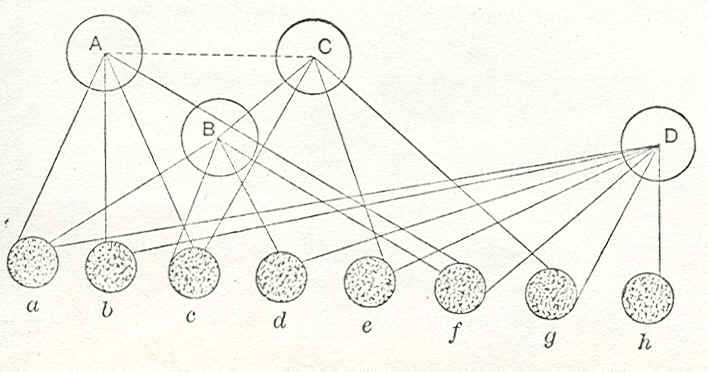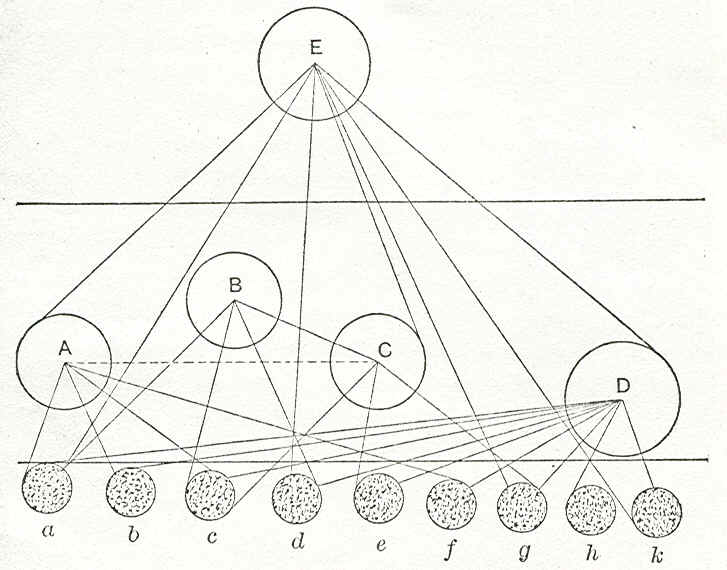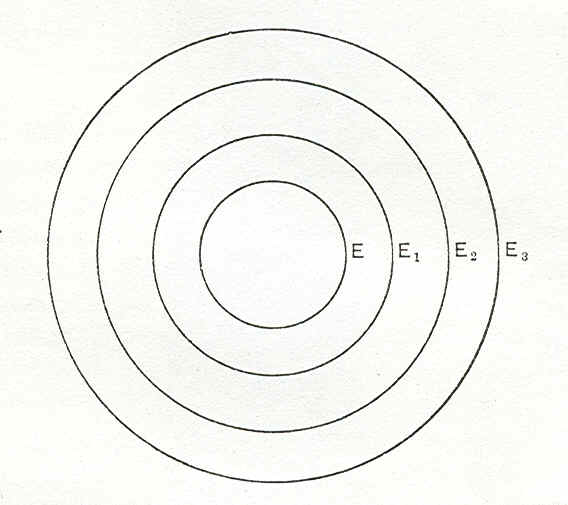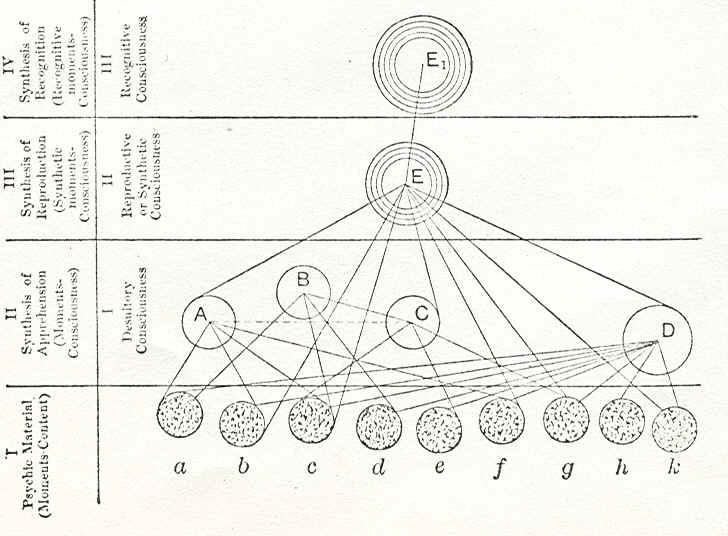| Home
Boris
Sidis Archives Menu Table of Contents
Next Chapter
CHAPTER XX THE ELEMENTS AND STAGES OF SUBCONSCIOUSNESS FROM the standpoint gained in our discussion on personality or the "pure ego" we can once more turn to the study of the secondary self. The secondary or subconscious self must not be regarded as an individual; it is only a form of mental life, and as such may belong to one of the three types of consciousness. It may be desultory, synthetic, or recognitive. The secondary consciousness is recognitive at its highest, desultory at its lowest. The subconscious self is a co-ordination of many series of moments-consciousness. In the subconsciousness series of moments-consciousness form groups, systems, communities, clusters, constellations. This co-ordination of series, however, can be dissolved; each separate series again can be broken up into its constituent moments, which may be endowed with a conscious tendency to reunite at a stated interval. The content of the isolated moment. is not any more represented in the moments of the other series, and is not therefore I known or cognized by them. The inhibited content knowledge or object consciousness has not disappeared; it is still present in the dissociated moments, and can I be revealed by different methods. Synthesis and catalysis of moments consciousness are at the heart of the subconscious. The catalysis of moments-consciousness is often brought about by psychic stimuli under the conditions of suggestibility―conditions that favour a dissociation of the primary from the secondary consciousness. Once this dissociation is effected, a catalysis of the constellations of moments-consciousness constituting the subconsciousness may be produced by suggestion and by other means. A dissociation of consciousness may be effected by the impression of a very powerful stimulus, such as a strong shock. The conditions of suggestibility―conditions that favour disaggregation of the upper from the lower consciousness, conditions that lay bare the subconscious self to the influence of external stimuli―are here brought about by the overpowering intensity of the stimulus. An intense, overpowering shock limits the activity of the voluntary muscles―frequently paralyzes them momentarily, and sometimes for an appreciable period of time fixes the attention on the impression to the exclusion of all else, strongly inhibits all other mental activity, and narrows the field of the upper consciousness―in fact, very often totally removes it. The subconscious self thus emerges. If the stimulus is too strong even for the secondary self, the disaggregation goes still further, the subconsciousness becomes disaggregated in its turn, and falls from the plane of recognitive to that of synthetic consciousness. With a further increase of the stimulus the dissolution goes on further, the disaggregation becomes deeper, and the subconsciousness falls from the level of synthetic to that of desultory consciousness. Now; if such a disaggregation of moments consciousness occurs, whatever may be the cause of it, if the moments can not get synthetized, and if new combinations with different psychic contents are formed, then the result is amnesia―amnesia for that particular state of moment-consciousness. We must discriminate between the psychic content that may be characterized as the moment-content of consciousness and the synthesis of that content. It is this synthesis of thc content that constitutes the nature of a moment-consciousness. In short, a moment-consciousness is content plus synthesis. Psychic or moment-contents may be represented in the synthesis of different moments-consciousness, so that while certain moments-consciousness may be entirely cut off from given psychic contents, other moments may bc in full possession of all that material. Thus there may be loss of mental experience and amnesia for certain states of consciousness, and at the same time full presence of that mental experience as well as recollection of it in other states of consciousness. The relation of the moments-consciousness to the psychic contents and their synthesis by different moments-consciousness at different levels of consciousness may be graphically represented in the following diagram:
In this diagram the granulated circles a, b, c, d, e, f, g, h stand for the moment-content or masses of psychic material, while the nucleated circles A, B, C, D, the centres of which form foci for the convergent lines from different moments-content, stand for momentsconsciousness. A synthetizes a, b, c, f ; B synthetizes a, c, d, f ; C synthetizes c, e, g ; and D synthetizes all the moments-content. Moment-content c is represented in all the moments-consciousness, while the rest of the moments-content are represented in different combinations in each of the moments-consciousness. Furthermore, there may also be communications between the moments-consciousness. Some of the psychic material directly presented to and synthetized by one moment-consciousness may be transmitted to and represented in another moment. Such is, in fact, very often the case. The dotted line that connects A with C represents such a relation. The moments-consciousness may be connected by association of contiguity, so that if one begins to function, the other moment is also set into activity. The line connecting Band C represents such a relation. D represents a moment-consciousness which, although it synthetizes all the moments-content, is altogether dissociated from the rest of moments-consciousness. This stage of synthesis may be termed primary synthesis, or synthesis of apprehension. There may be a higher stage of synthesis than the one just considered, and that is when a moment-consciousness synthetizes not only moments-content but also moments-consciousness. This stage of synthesis may bc termed secondary synthesis, or synthesis of apprehension and reproduction. The secondary stage of synthesis may be represented in the following diagram:
The moment consciousness E in the diagram is represented to be one that possesses synthesis of apprehension and reproduction. Such a moment-consciousness may be termed the synthetic moment-consciousness, because it is in this stage that synthetic consciousness of whole series of moments-consciousness first appears. The synthetic moment-consciousness may change its synthetized moments-consciousness as well as its moments-content, but still, from the very nature of this type of consciousness, the fluctuations themselves are synthetized in their turn, for each successive beat of synthetic consciousness or each synthetic moment-consciousness synthetizes all the preceding moments. The beats of synthetic consciousness may be graphically represented as follows:
Each beat of synthetic consciousness is represented by one of the concentric circles E, E1, E2, E3, each succeeding circle including all the preceding ones. In the moment of synthetic consciousness, as we know from a previous discussion,1 the former synthetic moments are merely reproduced, but they are not recognised as former, as past. It is only an external observer who occupies a higher plane than that of the synthetic consciousness, it is only such an observer who can notice the reproduction in the synthetic moment. There is, then, a higher plane of consciousness where a new synthesis is effected―that of recognition. This synthesis of recognition is the highest stage that mere consciousness, which takes as yet no recognizance of itself, can attain. The stages of consciousness and their interconnections in relation to the nature and range of growth of the subconscious self are graphically represented in the following diagram:
________________ 1. Vide Chapter XIX.
|



